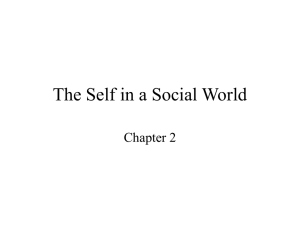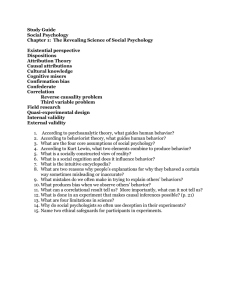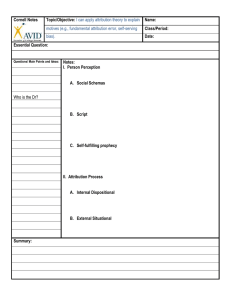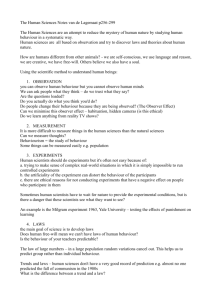File
advertisement
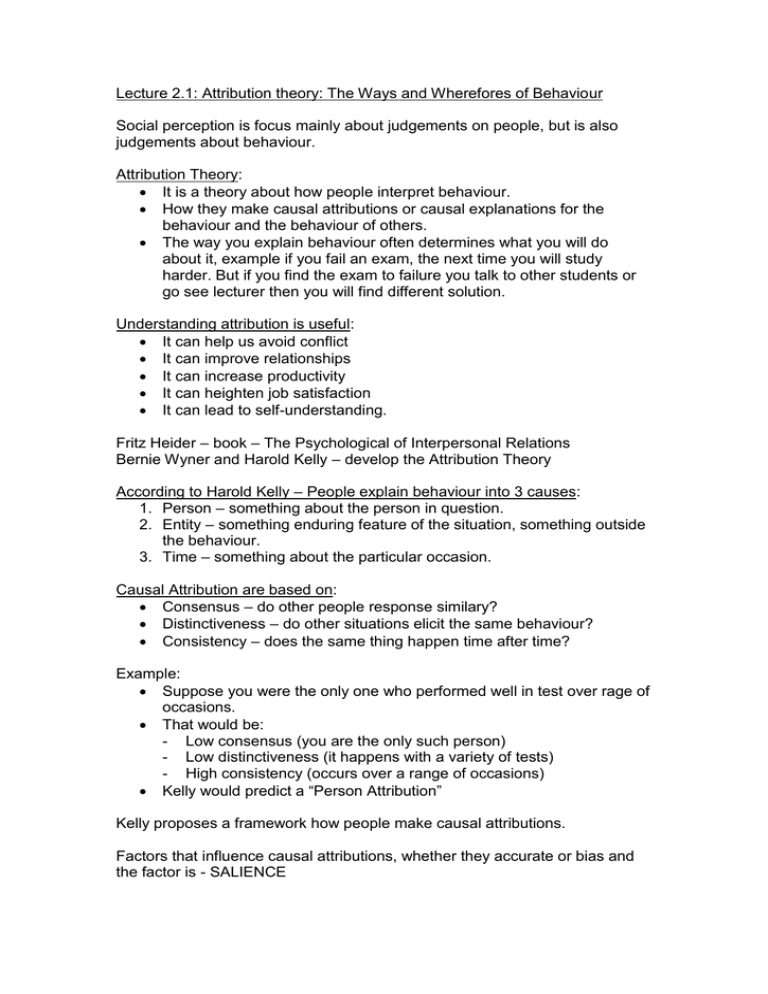
Lecture 2.1: Attribution theory: The Ways and Wherefores of Behaviour Social perception is focus mainly about judgements on people, but is also judgements about behaviour. Attribution Theory: It is a theory about how people interpret behaviour. How they make causal attributions or causal explanations for the behaviour and the behaviour of others. The way you explain behaviour often determines what you will do about it, example if you fail an exam, the next time you will study harder. But if you find the exam to failure you talk to other students or go see lecturer then you will find different solution. Understanding attribution is useful: It can help us avoid conflict It can improve relationships It can increase productivity It can heighten job satisfaction It can lead to self-understanding. Fritz Heider – book – The Psychological of Interpersonal Relations Bernie Wyner and Harold Kelly – develop the Attribution Theory According to Harold Kelly – People explain behaviour into 3 causes: 1. Person – something about the person in question. 2. Entity – something enduring feature of the situation, something outside the behaviour. 3. Time – something about the particular occasion. Causal Attribution are based on: Consensus – do other people response similary? Distinctiveness – do other situations elicit the same behaviour? Consistency – does the same thing happen time after time? Example: Suppose you were the only one who performed well in test over rage of occasions. That would be: - Low consensus (you are the only such person) - Low distinctiveness (it happens with a variety of tests) - High consistency (occurs over a range of occasions) Kelly would predict a “Person Attribution” Kelly proposes a framework how people make causal attributions. Factors that influence causal attributions, whether they accurate or bias and the factor is - SALIENCE SALIENCE: stimulus is one that grabs your attention. Research findings: - That salient stimulu – tend to be view as disproportionalty causal. - 1978 – Land mark Paper was published - Shelly Taylor & Susan Fiske – Social Psychologists. - Studies found the link between salience and causal attributions. Salience and Causal Attributions: General the more salient the stimulus is, the more likely it is to be viewed as causal – course of behaviour. Perceptions of causality are partly a function of where one’s attention is directed. And attention is turned a function of salience. Experiment of the prosecutor and the guilty guy: (results) Observers tend to rate the person’s behaviour in the visual field. - Set the tone of the conversation - Been the one who determined the type of information changed. - Caused the other person’s responses. Why does it matter: If we want to make judgements what lead somebody to behave in a certain way or who is responsible or guilty. Why do not want to be influence by where we are looking at the moment we making the judgment. If not careful this can happen: Research by Dan Lassitter: When the camera focus on suspect people are likely to see suspect as guilty. New Zealand law that camera need to focus on suspect and prosecutor. When there is a problem when a team is defeated or group fails – then people who are SALIENT cause they look different or sound different are at risk of becoming “SCATE CODED” – that is blamed because their salient makes them seem more causal more responsible. MAIN POINT: Causal Attribution is not a matter of logical deduction also a matter of sense repreception, what we are looking at the moment or happened to be hearing at the moment. WE COME BACK TO: Psychological Construction of Reality – usually makes logical casual attributions but not always – this will discuss in next topic. Reading 2.1: The Self in a Social World Part 1: Social Thinking: The definition of Social Psychology: the scientific study of how we think about: influence (part 1) and to relate (part 2) and to relate (part 3) how the research and the theories of social psychology are applied to real life. (part 4) Chapter One: Examines the scientific study of how we think about one another also called social cognition. Chapter 2: Explores the interplay between our sense of self and our social worlds. How do our social surroundings shape our self-identities? How does self-interest colour our social judgements and motivate our social behaviour? Chapter 3: Looks at the amazing and sometimes rather amusing ways we form beliefs about our social worlds. Chapter 4: Explores the links between our thinking and our actions, between our thinking and our attitudes and our behavior. Do our attitudes determine our behavior or visa versa? 1.SPOTLIGHTS AND ILLISIONS WHAT DO THEY TEACH US ABOUT OURSELVES? Definition The Spotlight effect: The belief that others are paying more attention to our appearance and behaviour that they are really are. Illusion of transparency: The illusion that our concealed emotions leak out and can be read by others. SUMMING UP: Spotlight and Illusions: What do they teach us about ourselves? Concerned with the impression we make on others, we tend to believe that others are paying more attention to us than they are: the spotlight effect. We also tend to believe that our emotions are more obvious than they are: the illusion of transparency. 2. SELF-CONCEPT: WHO AM I? Understand how, and how accurately, we know ourselves and what determines our self-concept. Definitions: Self-concept: What we know and believe about ourselves. Self-Schema: Beliefs about the self that organize and guide the processing of self-relevant information. Possible selves: Images what we dream of or dread becoming in the future. Social Comparison: Evaluating one’s abilities and opinions by comparing oneself with others. Individualism: The concept of giving priority to one’s own goals over group goals and defining one’s identity in terms of personal attributes rather than group identifications. Independent Self: Construing one’s identity as autonomous self. Collectivism: Giving priority to the goals of one’s group and defining one’s identity accordingly. Interdependent self: Construing one’s identity in relation to others. Planning Fallacy: The tendency to underestimate how long it will take to complete a task. Impact Bias: Overestimating the enduring impact of emotion-causing events. Immune Neglect: The human tendency to underestimate the speed and the strength of the “psychological immune system”, which enables emotional recovery and resilience after bad things happen. Dual Attitude System: Differing implicit (automatic) and explicit (consciously controlled) attitudes toward the same objects. Verbalized explicit attitudes may change with education and persuasion. Implicit attitudes change slowly, with practice that forms new habit. SUMMING UP: Self-Concept; Who am I? Our sense of self helps organize our thoughts and actions. When we process information with reference to ourselves, we remember it well (the self-reference effect). Self-concept consists of two elements: the self-schemas that guide our processing of self-relevant information and the possible selves that we dream of or dread. Cultures shape the self too. Many people in individualistic western cultures assume an independent self. Others, often in collectivistic cultures, assume a more interdependent self. Our self-knowledge is curiously flawed. We often do not know why we behave the way we do. When influences upon our behaviour are not conspicuous enough for any observers to see, we too, can miss them. The unconscious, implicit processes that control our behaviour may differ from our conscious, explicit explanations of it. We also tend to mispredict our emotions. We underestimate the power of our psychological immune systems and thus tend to overestimate the durability of our emotional reactions to significant events. 3.WHAT IS THE NATURE AND MOTIVATING POWER OF SELF-ESTEEM? Understand self-esteem and its implications for behaviour and cognition. Definitions: Self-Esteem: A person’s overall self-evaluation or sense of self-worth. Terror Management Theory: Proposes that people exhibit self-protective emotional and cognitive responses (including adhering more strongly to their cultural world viewers and prejudices) when confronted with reminders of their mortality. SUMMING UP: What is the nature and motivating power of self-esteem? Self-esteem is the overall sense of self-worth we use to appraise our traits and abilities. Our self-concepts are determined by multiple influences, including the roles we play, the comparisons we make, our social identities, how we perceive others appraising us, and our experiences of success and failure. Self-esteem motivation influences our cognitive processes. Facing failure, high-self-esteem people sustain their self-worth by perceiving other people as failing too, and by exaggerating their superiority over others. Although high-self-esteem is generally more beneficial than low, researchers have found that people high in both self-esteem and narcissism are the most aggressive. Someone with a big ego who is threatened or deflated by social rejection is potentially aggressive. 4.WHAT DOES IT MEAN TO HAVE “PERCEIVED SELF-CONTROL”? Understand self-concept through examination of the self in action. Definitions: Self-efficacy: A sense that one is competent and effective, distinguished from self-esteem, which is one’s sense of self-worth. As sharpshooter in the military might feel high self-efficacy and low self-esteem. Locus of Control: The extent to which people perceive outcomes as internally controllable by their own efforts or as externally controlled by chance or outside forces. Learned Helplessness: The sense of hopelessness and resignation learned when a human or animal perceives no control over repeated bad events. SUMMING UP: What does it mean to have “perceived self-control”? Several lines of research show the benefits of a sense of self-efficacy and feelings of control. People who believe in their own competence and effectiveness, and who have internal locus of control, cope better and achieve more than others. Learned helplessness often occurs when attempts to improve a situation have proven fruitless; self-determination, in contrast is bolstered by experiences of successfully exercising control and improving one’s situation. When people are given too many choices, they may be less satisfied with what they have when offered a smaller range of choices. 5.WHAT IS SELF-SERVING BIAS? Explain self-serving bias and its adaptive and maladaptive aspects. Definitions: Self-Serving Bias: The tendency to perceive oneself favorably. Self-Serving Attributions: A form of self-serving bias; the tendency to attribute positive outcomes to oneself and negative outcomes to other factors. Defensive Pessimism: The adaptive value of anticipating problems and harnessing one’s anxiety to motivate effective action. False Consensus Effect: The tendency to overestimate the commonality of one’s opinions and one’s undesirable or unsuccessful behaviors. False Uniqueness Effect: The tendency to underestimate the commonality of one’s abilities and one’s desirable or successful behaviors. Group-Serving Bias: Explaining away outgroup members positive behaviors; also attributing negative behaviors to their dispositions (while excusing such behaviour by one’s own group. SUMMING UP: What is self-serving bias? Contrary to the presumption that most people suffer from low selfesteem or feelings of inferiority, researchers consistently find that most people exhibit a self-serving bias. In experiments and everyday life, we often take credit for our successes while blaming failures on the situation. Most people rate themselves as better than average on subjective, desirable traits and abilities. We exhibit unrealistic optimism about our futures. We overestimate the commonality of our opinions and foibles (false consensus) while underestimating the commonality of our abilities and virtues (false uniqueness). Such perceptions arise partly from a motive to maintain and enhance self-esteem – a motive that protects people from depression but contributes to misjudgement and group conflict. Self-serving bias can be adaptive in that it allows us to savor the good things that happen in our lives. When bad things happen, however, self-serving bias can have the maladaptive effect of causing us to blame others or feel cheated out of something we “deserved”. 6. HOW DO PEOPLE MANAGE THEIR SELF-PRESENTATION? Identify self-presentation and understand how impression management can explain behavior. Definitions: Self-handicapping: Protecting one’s self-image with behaviors that create a handy excuse for later failure. Self-Presentation: The act of expressing oneself and behaving in ways designed to create a favorable impression or an impression that correspond to one’s ideals. Self-Monitoring: Being attuned to the way one presents oneself in social situations and adjusting one’s performance to create the desired impression. SUMMING UP: How do people manage their self-presentation: As social animals, we adjust our words and actions to suite our audience. To varying degrees, we note our performance and adjust it to create the impression we desire. Such tactics explains examples of false modesty, in which people put themselves down, extol future competitors, or publicly credit others while privately crediting themselves. Sometimes people will even self-handicap with self-defeating behaviors that protect self-esteem by providing excuses for failure. Self-presentation refers to our wanting to present a favorable image both to an external audience (other people) and to an internal audience, those who score high on a scale of self-monitoring adjust their behaviour to each situation, whereas those low in self-monitoring may do so little social adjusting that they seem insensitive.
